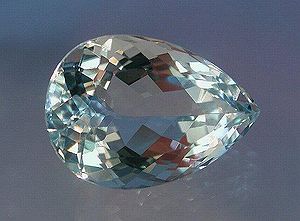Aquamarine
| Aquamarine | |
|---|---|
 |
|
| Aquamarine | |
| General | |
| Category | Variety of beryl |
| Chemical formula | Be3Al2Si6O18[1] |
| Identification | |
| Color | transparent (or can be translucent if included), greenish blue to blue green, typically light in tone[1] |
| Crystal system | hexagonal[1] |
| Cleavage | very difficult in one direction, almost never seen[1] |
| Fracture | conchoidal[1] |
| Mohs Scale hardness | 7.5 - 8[1] |
| Luster | vitreous to resinous[1] |
| Polish luster | vitreous [1] |
| Refractive index | 1.577 - 1.583 (+/- .017)[1] |
| Optical Properties | Double refractive, uniaxial negative[1] |
| Birefringence | .005 - .009[1] |
| Dispersion | .014[1] |
| Pleochroism | weak to moderate, blue and greenish blue; or different tones of blue with lighter tones associated with the optic axis direction [1] |
| Ultraviolet fluorescence | inert[1] |
| Absorption spectra | indistinct lines at 537 and 456nm. Depending on the depth of color, there is a strong line at 427nm.[1] |
| Specific gravity | 2.72 (+.18, -.05)[1] |
Aquamarine (Lat. aqua marina, "water of the sea") is a gemstone-quality transparent variety of beryl, having a delicate blue or turquoise color, suggestive of the tint of seawater. It is closely related to the gem emerald. Colors vary, and in addition to blue, yellow beryl (heliodor), rose pink beryl (morganite), and white beryl (goshenite) are also to be found.
Contents |
Composition
Aquamarine is a beryl with a hexagonal crystal structure and a chemical formula of Be3Al2(SiO3)6, a beryllium aluminium silicate mineral. It has a specific gravity of 2.68 to 2.74 and a Mohs hardness of from 7.5 to 8. Aquamarine typically is on the low end of the specific gravity range, normally at less than 2.7. The pink variety exhibits a high specific gravity of around 2.8. Refractive indices range around 1.57 to 1.58.
Locations of deposits
It occurs at most localities which yield ordinary beryl, some of the finest coming from Russia. The gem-gravel placer deposits of Sri Lanka contain aquamarine. Clear yellow beryl, such as occurs in Brazil, is sometimes called aquamarine chrysolite. When corundum presents the bluish tint of typical aquamarine, it is often termed Oriental aquamarine.
In the United States, aquamarines can be found at the summit of Mt. Antero in the Sawatch Range in central Colorado. In Wyoming, aquamarine has been discovered in the Big Horn mountains, near Powder River Pass. In Brazil, there are mines in the states of Minas Gerais, Espírito Santo and Bahia. Colombia, Zambia, Madagascar, Malawi, Tanzania and Kenya also produce aquamarine.
The biggest aquamarine ever mined was found at the city of Marambaia, Minas Gerais, Brazil, in 1910. It weighed over 110 kg, and its dimensions were 48.5 cm long and 42 cm in diameter.
Culture and historical/mythical usage
- Aquamarine (along with bloodstone) is the birthstone associated with March. It is also the gemstone for the 19th Anniversary.
- People in the Middle Ages thought that aquamarine could magically overcome the effects of poison.
- Ancient sailors traveled with aquamarine crystals, believing that it would ensure a safe voyage, and guarantee a safe return; they often slept with the stones under their pillow to ensure sound sleep. They believed the siren’s (mermaid) fish-like lower body was made of aquamarine.
See also

- List of minerals
References
- ↑ 1.00 1.01 1.02 1.03 1.04 1.05 1.06 1.07 1.08 1.09 1.10 1.11 1.12 1.13 1.14 1.15 Gemological Institute of America, GIA Gem Reference Guide 1995, ISBN:0-87311-019-6
- Weinstein, Michael, 1958, The World of Jewel Stones Sheriden House, New York, pp 104-107
- Diamond Bug. "Flawless Aquamarine: March Birthstone". Retrieved March 16, 2006.
- http://www.gemstone.org/gem-by-gem/english/aquamarine.html
- http://mineral.galleries.com/minerals/gemstone/aquamari/aquamari.htm
- http://www.mindat.org/min-289.html
- http://aquamarine.com/gemology/how-the-aquamarine-gets-its-color/
|
|||||||||||||||||